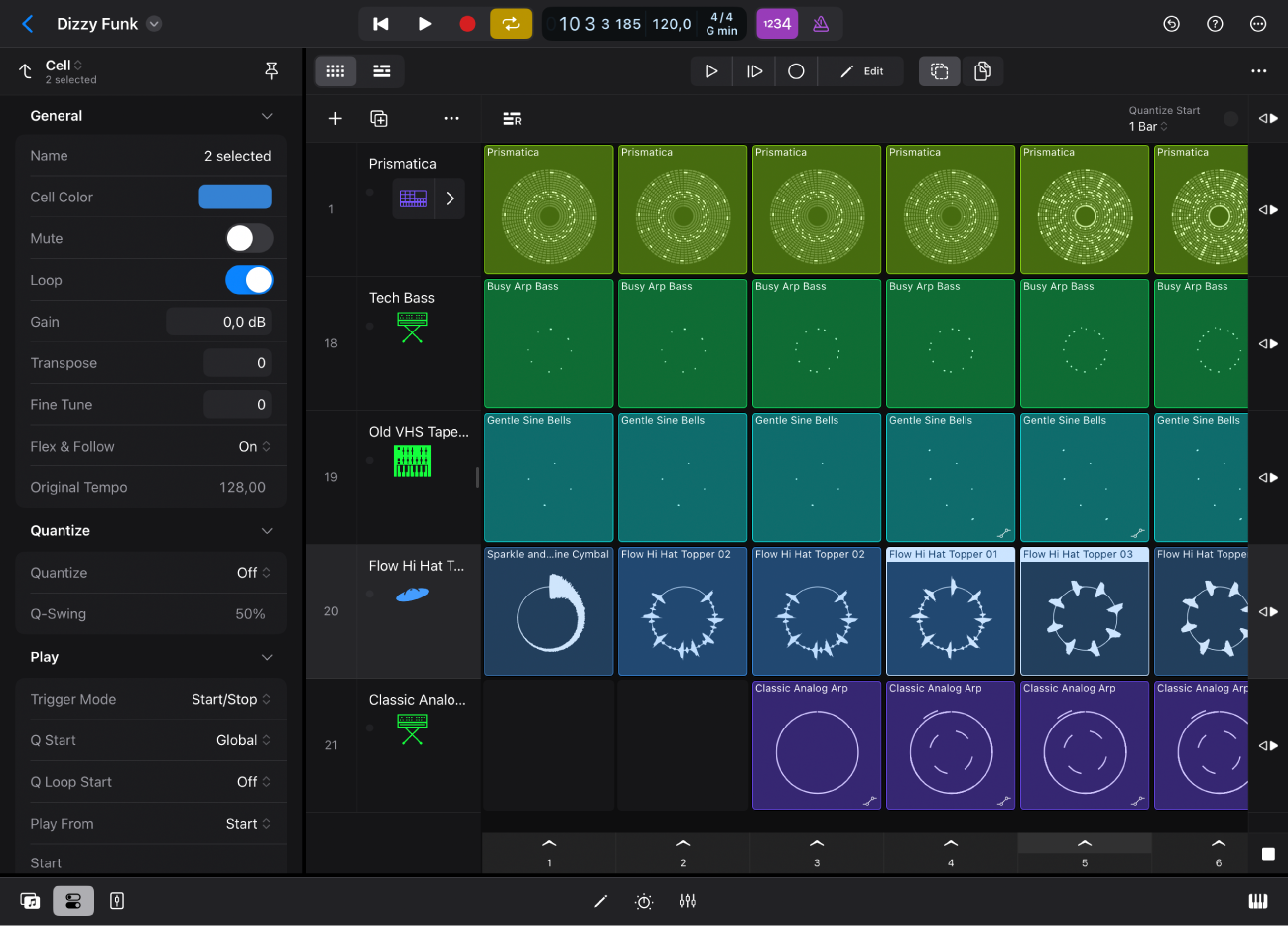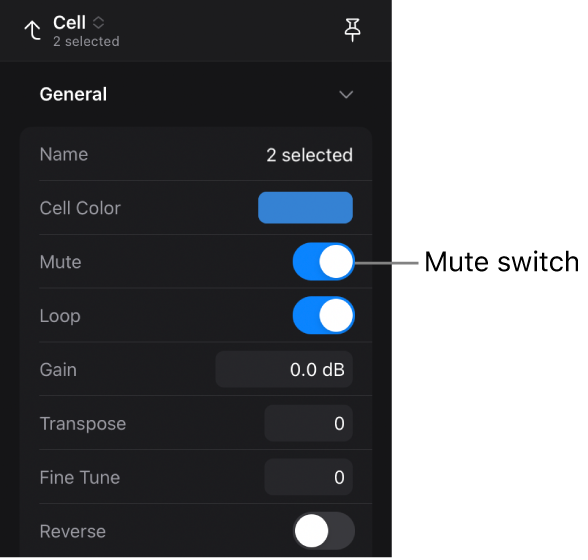Logic Pro User Guide for iPad
-
- What is Logic Pro?
- Working areas
- Work with function buttons
- Work with numeric values
-
- Intro to tracks
- Create tracks
- Create tracks using drag and drop
- Choose the default region type for a software instrument track
- Select tracks
- Duplicate tracks
- Reorder tracks
- Rename tracks
- Change track icons
- Change track colors
- Use the tuner on an audio track
- Show the output track in the Tracks area
- Delete tracks
- Edit track parameters
- Start a Logic Pro subscription
- How to get help
-
- Intro to recording
-
- Before recording software instruments
- Record software instruments
- Record additional software instrument takes
- Record to multiple software instrument tracks
- Record multiple MIDI devices to multiple tracks
- Record software instruments and audio simultaneously
- Merge software instrument recordings
- Spot erase software instrument recordings
- Replace software instrument recordings
- Capture your most recent MIDI performance
- Route MIDI internally to software instrument tracks
- Record with Low Latency Monitoring mode
- Use the metronome
- Use the count-in
-
- Intro to arranging
-
- Intro to regions
- Select regions
- Cut, copy, and paste regions
- Move regions
- Remove gaps between regions
- Delay region playback
- Trim regions
- Loop regions
- Repeat regions
- Mute regions
- Split and join regions
- Stretch regions
- Separate a MIDI region by note pitch
- Bounce regions in place
- Change the gain of audio regions
- Create regions in the Tracks area
- Convert a MIDI region to a Session Player region or a pattern region
- Rename regions
- Change the color of regions
- Delete regions
-
- Intro to chords
- Add and delete chords
- Select chords
- Cut, copy, and paste chords
- Move and resize chords
- Loop chords on the Chord track
- Edit chords
- Work with chord groups
- Use chord progressions
- Change the chord rhythm
- Choose which chords a Session Player region follows
- Analyze the key signature of a range of chords
- Create fades on audio regions
- Extract vocal and instrumental stems with Stem Splitter
- Access mixing functions using the Fader
-
- Intro to Step Sequencer
- Use Step Sequencer with Drum Machine Designer
- Record Step Sequencer patterns live
- Step record Step Sequencer patterns
- Load and save patterns
- Modify pattern playback
- Edit steps
- Edit rows
- Edit Step Sequencer pattern, row, and step settings in the inspector
- Customize Step Sequencer
-
- Effect plug-ins overview
-
- Instrument plug-ins overview
-
- ES2 overview
- Interface overview
-
- Modulation overview
- Use the Mod Pad
-
- Vector Envelope overview
- Use Vector Envelope points
- Use Vector Envelope solo and sustain points
- Set Vector Envelope segment times
- Vector Envelope XY pad controls
- Vector Envelope Actions menu
- Vector Envelope loop controls
- Vector Envelope point transition shapes
- Vector Envelope release phase behavior
- Use Vector Envelope time scaling
- Modulation source reference
- Via modulation source reference
-
- Sample Alchemy overview
- Interface overview
- Add source material
- Save a preset
- Edit mode
- Play modes
- Source overview
- Synthesis modes
- Granular controls
- Additive effects
- Additive effect controls
- Spectral effect
- Spectral effect controls
- Filter module
- Low, bandpass, and highpass filters
- Comb PM filter
- Downsampler filter
- FM filter
- Envelope generators
- Mod Matrix
- Modulation routing
- Motion mode
- Trim mode
- More menu
- Sampler
- Studio Piano
- Copyright
Edit Live Loops cells in Logic Pro for iPad
You can arrange and edit cells in the Live Loops grid in a variety of ways. When you turn on Cell Edit mode, you can select, cut, copy, and paste cells; move cells; delete cells; and change cell settings. If you use an external computer keyboard with your iPad, you can use keyboard shortcuts to perform many of these editing functions. See Overview of keyboard shortcuts in Logic Pro for iPad.
If you use a trackpad with your iPad, you can click a cell with two fingers to access and edit various parameters, regardless of which editing mode you are in. See Use a trackpad with Logic Pro for iPad.

In Cell Edit mode, you can’t start or stop playback of cells, but you can edit cells that are already playing. You can change most settings for selected cells in the Cell inspector. When you select a single cell, the name of the cell is visible near the top of the Cell inspector; when you select multiple cells, the number of selected cells is visible.
You can use the Cell Editor to view and edit the regions in cells, similar to how you edit regions in the Piano Roll Editor, Audio Editor, Step Sequencer, and Session Player Editor.
Turn on Cell Edit mode
Tap the Cell Edit button
 in the Live Loops menu bar.
in the Live Loops menu bar.
Select cells in the Live Loops grid
In Logic Pro, turn on Cell Edit mode, and do either of the following:
Select a single cell: Tap a cell.
Select multiple cells: Do any of the following:
Tap the Multiple Select button
 , then tap cells to select them.
, then tap cells to select them.In order to edit the cells you selected, tap the Multiple Select button again when you are done with your selection.
Touch and hold any empty cell, then drag over cells to select them.
Select all cells: Double-tap a cell, then choose Select > All Cells from the menu.
Select all following cells: Double-tap a cell, then choose Select > All Following Cells from the menu.
All cells in the same scene, and all other cells to the right, are selected.
Select all following cells on the same track: Select one or more cells, tap one of the selected cells, then choose Select > All Following Cells of Same Track from the menu.
All of the cells to the right of, and on the same track as, the selected cells are selected.
Select all cells on the same track: Select one or more cells, tap one of the selected cells, then choose Select > All Cells of Same Track from the menu.
Select all cells in the same scene: Select one or more cells, tap one of the selected cells, then choose Select > All Cells of Same Scene from the menu.
Select all cells of the same color: Select one or more cells, tap one of the selected cells, then choose Select > Same-Colored Cells from the menu.
Invert selection: Select one or more cells, tap one of the selected cells, then choose Select > Invert Selection from the menu.
Copy and paste cells
In Logic Pro, turn on Cell Edit mode, then select one or more cells.
Tap any selected cell, then tap Copy.
Note: If you want to remove the cell from its original location, tap Cut instead.
Double-tap where want to paste the cell, then tap Paste.
If you paste cells to cells that already contain content, the new content replaces the existing content.
Move a cell
You can move cells to an empty or filled cell in the same row, or to another row of the same type. For example, you can move an audio cell to another row with audio cells, but not to a row with software instrument cells, and vice versa. If you move cells to cells that already contain content, the new content replaces the existing content.
In Logic Pro, turn on Cell Edit mode, then select one or more cells.
Touch and hold one of the selected cells, then drag it to the cell you want to move it to.
Rename a cell
In Logic Pro, turn on Cell Edit mode, then select the cell you want to rename.
Tap the Inspector button
 to open the Cell inspector.
to open the Cell inspector.Tap the name of the cell, enter a new name, then tap Return.
Delete a cell
In Logic Pro, turn on Cell Edit mode, then select one or more cells.
Tap one of the selected cells, then tap Delete in the menu.
Mute a cell
When you mute a cell, it stops playing. To hear the cell again, you must unmute it and then restart it.
In Logic Pro, turn on Cell Edit mode, then select one or more cells.
Tap the Inspector button
 to open the Cell inspector.
to open the Cell inspector.Under General settings, tap the Mute switch.

Set an audio cell to ignore project tempo
In some cases you might want an audio cell to ignore the project tempo and play at its original tempo. This can be useful if you have cells containing spoken word, a one-shot, or nonlooping sound effects, for example.
In Logic Pro, turn on Cell Edit mode, then select one or more audio cells.
Tap the Inspector button
 to open the Cell inspector.
to open the Cell inspector.Under General settings, tap the value for Flex & Follow, then tap Off.
Change the playback speed of a cell
In Logic Pro, turn on Cell Edit mode, then select one or more cells.
Tap the Inspector button
 to open the Cell inspector.
to open the Cell inspector.Under General settings, tap the value for Speed, then choose a value.
The Speed parameter is not available for cells containing recorded audio that have Flex & Follow turned on in the Cell inspector.
Reverse cell playback
In Logic Pro, turn on Cell Edit mode, then select one or more cells.
Tap the Inspector button
 to open the Cell inspector.
to open the Cell inspector.Under General settings, tap the Reverse switch.
The Reverse setting is not available for cells containing recorded audio that have Flex & Follow turned on in the Cell inspector.
Download this guide: PDF